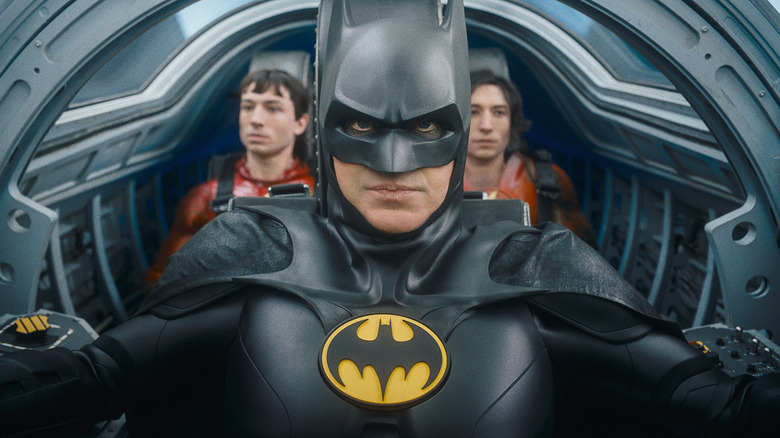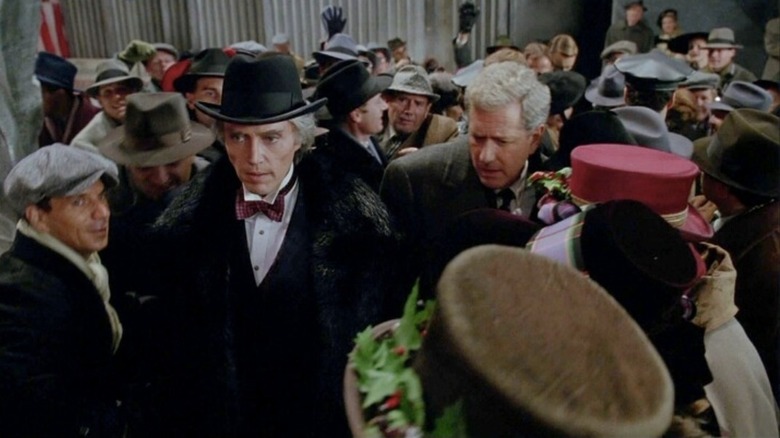The Flash Director Didn't Emulate Tim Burton's Visual Style Because It Required Too Many Hats
This article contains spoilers for "The Flash."
Now that it's becoming commonplace for modern superhero movies to dip into the past and pull entire characters out of pre-established franchise continuities, more and more filmmakers have to grapple with a bit of a thorny question. When bringing Tobey Maguire's Peter Parker and Willem Dafoe's Norman Osborn out of "Spider-Man" (2002) and into the Marvel Cinematic Universe, should their scenes together in "Spider-Man: No Way Home" have adopted the same stylistic qualities that director Sam Raimi is so well known for? Or take "The Flash," which decided to revisit one of the most visually distinct superhero movies ever made — Tim Burton's "Batman" (1989) — and bring back Michael Keaton's Bruce Wayne out of retirement. Andy Muschietti certainly leaves his stamp on every movie he makes (likely including the upcoming "Batman: Brave and the Bold," as was just revealed) , but "The Flash" doesn't exactly borrow any of the Gothic expressionism that Burton so clearly loved.
It should come as no surprise that there's a very good reason why Muschietti didn't want to emulate the Burton movies too much. The plot of "The Flash" involves Ezra Miller's Barry Allen being forcibly shoved out of the Speed Force when traveling back to the past and thrown into a whole other timeline. We're meant to assume that his plan to alter history actually worked without a hitch, saving the life of his mother and preventing his father from imprisonment. But after he runs into his younger self, he realizes that he's erased multiple members of the "Justice League" from existence and discovers that he has no idea who this world's Bruce Wayne is — even though we do.
So why avoid the Burton of it all? It had to do with ... hats. Obviously!
Best of both worlds
If you can't beat 'em, best to not even try to join 'em. While some fans may find it jarring to see Michael Keaton's Batman running around in such a modern setting with a wildly different sense of atmosphere in "The Flash," there was a method to the madness. While making a recent appearance on IndieWire's Filmmaker Toolkit podcast, director Andy Muschietti revealed why he felt so strongly about separating himself from Tim Burton's famous aesthetics. In essence, hewing too close to Burton's style would've given away the entire game. According to Muschietti:
"How do we integrate a movie that is, tonally, so different? One thing I knew for sure was that I wouldn't try to emulate the cinematography of [Burton's movies] because it would be completely tonally different, but also, it would alert audiences that the world in which Barry lands is a Tim Burton movie. If you go 100% in that direction, you would have to have people with hats and stuff, and this blue-blasted backlights that are so particular in his movies. The level of fantasy in the design would be prohibitive in my movie, so I tried to blend the two worlds, and I think we managed to reach a balance where it's still believable that the Michael Keaton Batman exists in this timeline."
We wouldn't be doing our due diligence if we didn't observe the hilarity of the quote, "You would have to have people with hats and stuff." But Muschietti makes a solid point! Revisit both Burton "Batman" movies and it's obvious why that wouldn't have translated well. As much as I would've loved to see extras wearing top hats and silhouetted by Gothic lighting in "The Flash," that was probably a non-starter.
"The Flash" is currently playing in theaters.

